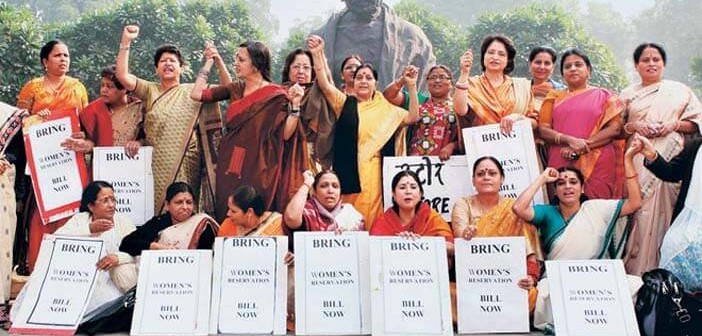Between the 5th Lok Sabha elections in 1971 to the 17th Lok Sabha elections in 2019, the share of women contestants of the total has increased from 3% to 9%. While the total number of contestants increased from 2,771 to 8,054 during this period, the number of women contestants has increased from 86 to 726. However, there have been wide variations across states.
In this series of stories on Indian Elections, our focus is to bring out some important, yet less covered aspects of the elections, and their trends over the last 17 Lok Sabha elections. The first part focused on independent candidates, the second part focused on overall contestants, deposits forfeited and the third part focused on disqualifications of candidates, both by way of electoral petitions and conviction in criminal cases.
In this fourth part, we look at the participation of women in Lok Sabha elections and their representation in the Lower House from states. For this, we analysed data available on Dataful. The data has been collated from the reports of the Election Commission of India and the Lok Sabha website.
Women’s participation in Lok Sabha is vital for inclusive governance, ensuring diverse perspectives and priorities are represented in policy-making. Their presence promotes gender equality, addresses women-specific issues effectively, and inspires future female leaders. This representation fosters a more robust democracy, leading to better-informed decisions and policies that cater to the diverse needs of society. Unfortunately, data shows that women’s representation in the Lok Sabha and other political bodies is relatively low.
Share of Women Contestants in general elections has increased from 3% in 1971 to 9% in 2019
Between the 5th Lok Sabha elections in 1971 and the 17th Lok Sabha elections in 2019, the share of women contestants in the total has increased from 3% to 9%. While the total number of contestants increased from 2,771 to 8,054 during this period, the number of women contestants has increased from 86 to 726. In other words, the average number of contestants per constituency has gone up from about 5 in the 1971 elections to almost 15 contestants in the 2019 elections. On the other hand, there has been at least one woman candidate on average from each constituency only since the 15th Lok Sabha elections in 2009. Though there has been a gradual increase in the number of women contestants in Lok Sabha elections over the years, it continues to be very low.
Share of Women Contestants has improved, but is still low
In terms of number of women contestants in the Lok Sabha elections from a state, Uttar Pradesh reported the highest with more than 700 women contestants between the 1971 and 2019 elections. However, Uttar Pradesh is also the state with the greatest number of Lok Sabha seats due to its large population which is why the state has a higher number of contestants including women. Similarly, Madhya Pradesh, Maharashtra, Andhra Pradesh, and Bihar also had a higher number of women contestants.
However, if the share of women contestants against the total number of contestants in a state is considered, their share ranges in major states from about 2% in Himachal Pradesh to about 14% in Odisha during the 2019 elections. The share in Telangana was only 6% in the Lok Sabha elections after its official formation.
A gradual increase in the share of women contestants is evident in most of the states including Odisha, West Bengal, Uttar Pradesh, Kerala, Maharashtra, Madhya Pradesh, and Tamil Nadu. During the 14th and 15th Lok Sabha elections in 2004 and 2009, there was a drop in the share of women contestants in states like Bihar, Karnataka, and Punjab, following which it has increased. Odisha is one state where there has been a considerable increase in the share of women contestants – from 2% in 1971 to 14% in 2019. In majority of the states, the increase has been in the range of 6 to 8 percentage points.
Share of women MPs in the Lok Sabha has risen to 15%
According to data on MPs from the Lok Sabha website, the total number of women MPs has increased from 28 during the 5th Lok Sabha to 82 during the 17th Lok Sabha term. That is, out of the total Lok Sabha members during a specific term, their share has gone up from 5% to nearly 15%. The 17th Lok Sabha had the highest number and share of women MPs ever. It should be noted that the number of MPs for a specific Lok Sabha term in the following chart may be more than the number of constituencies since it includes all the MPs during a term including those who were deceased, expelled, or resigned during a term, and those that were elected in a by-poll.
One-third of the MPs from Odisha in the 17th Lok Sabha are Women
The share of women out of all the MPs from a state has seen significant growth in some major states like Gujarat, West Bengal, and Maharashtra. Odisha is the only state which has reported one-third representation of women in the 17th Lok Sabha. This is the highest for any state ever. In fact, the state saw zero representation of women in the 15th Lok Sabha. Punjab had 30% representation in the 15th Lok Sabha. The states of Himachal Pradesh, Gujarat, West Bengal, and Chhattisgarh had a representation of more than 20% each in the 17th Lok Sabha. In the last three elections, the representation has dropped in the states of Bihar and Assam. Kerala and Tamil Nadu are two states where the share has never gone beyond 10%.
Though the share of women has increased, the number is still low
The participation of women in general elections as well as the representation of women in Lok Sabha across the states is considerably low even though there has been a gradual increase in the numbers over the years. In countries like New Zealand, Spain, Rwanda, Nordic countries, and Mexico, women constitute more than 40% of the representatives in their legislative bodies.
The women’s representation bill calls for reserving one-third of the seats for women
This data underscores the ongoing need for efforts to promote and support women’s participation in leadership roles in Indian politics at all levels of governance. One important step forward taken by the government is the passage of the Women’s Reservation Bill which is also referred to as Nari Shakti Vandan Adhiniyam which aims to reserve 33% seats for women in Lok Sabha and state Legislative Assemblies. The same is also applicable to the seats reserved for SCs and STs in Lok Sabha and state legislatures. The Bill will be effective after the Census data is published & delimitation is taken up. The bill holds the potential to bring about positive changes in women’s participation and representation in Indian politics.



